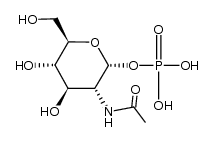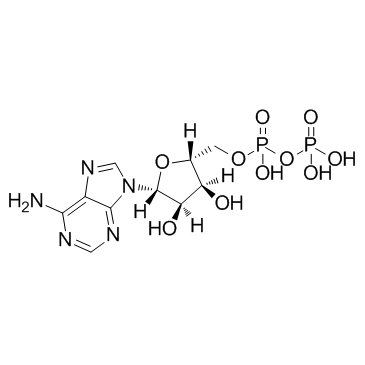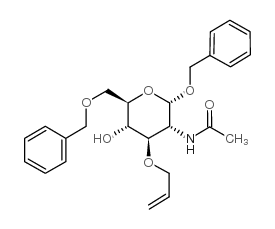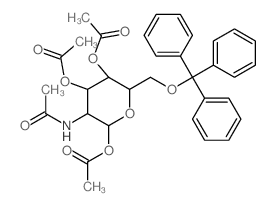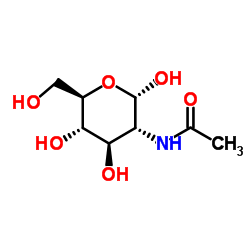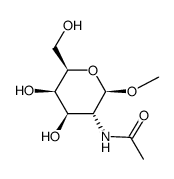10036-64-3
| 中文名 | 2-乙酰氨基-2-脱氧-Alpha-D-吡喃糖 |
|---|---|
| 英文名 | N-acetyl-α-D-glucosamine |
| 中文别名 |
乙酰氨基-联氧-古氨酶
2-乙酰氨基-2-脱氧-alpha-d-吡喃葡萄糖 |
| 英文别名 |
N-acetylglucosamine
α-D-GlcNAc EINECS 233-115-1 Glucosamine, N-acetyl- 2-acetylamino-2-deoxy-a-D-glucopyranose 2-acetylamino-2-deoxy-α-D-glucopyranose N-ACETYL-D-GLUCOSAMINE N-acetyl D-glucosamine N-ACETYL-α-D-GLUCOSAMINE MFCD00064359 2-Acetamido-2-deoxy-α-D-glucopyranose α-GlcNAc 2-Acetamido-2-deoxy-a-D-glucopyranose N-acetyl-δ-glucosamine N-acetyl-alpha-D-glucosamine 2-Acetamido-2-deoxy-alpha-D-glucopyranose α-D-Glucopyranose, 2-(acetylamino)-2-deoxy- 2-(acetylamino)-2-deoxy-α-D-glucopyranose 2-acetamido-2-deoxy-α-δ-glucopyranose α-N-Acetyl-D-glucosamine |
| 密度 | 1.5±0.1 g/cm3 |
|---|---|
| 沸点 | 595.4±50.0 °C at 760 mmHg |
| 熔点 | 211ºC |
| 分子式 | C8H15NO6 |
| 分子量 | 221.208 |
| 闪点 | 313.9±30.1 °C |
| 精确质量 | 221.089935 |
| PSA | 119.25000 |
| LogP | -2.48 |
| 外观性状 | 白色结晶粉末 |
| 蒸汽压 | 0.0±3.8 mmHg at 25°C |
| 折射率 | 1.576 |
| 储存条件 | 密闭于4ºC阴凉干燥环境中 |
| 稳定性 | 遵照规定使用和储存则不会分解。 |
| 分子结构 | 1、 摩尔折射率:48.57 2、 摩尔体积(m3/mol):146.8 3、 等张比容(90.2K):432.4 4、 表面张力(3.0 dyne/cm):75.1 5、 极化率(0.5 10 -24cm 3):19.25 |
| 计算化学 | 1、 疏水参数计算参考值(XlogP):-1.7 2、 氢键供体数量:5 3、 氢键受体数量:6 4、 可旋转化学键数量:2 5、 拓扑分子极性表面积(TPSA):119 6、 重原子数量:15 7、 表面电荷:0 8、 复杂度:235 9、 同位素原子数量:0 10、 确定原子立构中心数量:5 11、 不确定原子立构中心数量:0 12、 确定化学键立构中心数量:0 13、 不确定化学键立构中心数量:0 14、 共价键单元数量:1 |
| 更多 | 1. 性状:无可用 2. 密度(g/mL,25/4℃):无可用 3. 相对蒸汽密度(g/mL,空气=1):无可用 4. 熔点(ºC):211 5. 沸点(ºC,常压):无可用 6. 沸点(ºC,5.2kPa):无可用 7. 折射率:无可用 8. 闪点(ºC):无可用 9. 比旋光度(º):无可用 10. 自燃点或引燃温度(ºC):无可用 11. 蒸气压(kPa,25ºC):无可用 12. 饱和蒸气压(kPa,60ºC):无可用 13. 燃烧热(KJ/mol):无可用 14. 临界温度(ºC):无可用 15. 临界压力(KPa):无可用 16. 油水(辛醇/水)分配系数的对数值:无可用 17. 爆炸上限(%,V/V):无可用 18. 爆炸下限(%,V/V):无可用 19. 溶解性:无可用 |
Synonym:N-Acetyl-alpha-D-glucosamine Section 2 - COMPOSITION, INFORMATION ON INGREDIENTS
Risk Phrases: None Listed. Section 3 - HAZARDS IDENTIFICATION EMERGENCY OVERVIEW
The toxicological properties of this material have not been fully investigated. Potential Health Effects Eye: May cause eye irritation. Skin: May cause skin irritation. Ingestion: Ingestion of large amounts may cause gastrointestinal irritation. The toxicological properties of this substance have not been fully investigated. Inhalation: May cause respiratory tract irritation. The toxicological properties of this substance have not been fully investigated. Chronic: No information found. Section 4 - FIRST AID MEASURES Eyes: Immediately flush eyes with plenty of water for at least 15 minutes, occasionally lifting the upper and lower eyelids. Get medical aid immediately. Skin: Get medical aid. Flush skin with plenty of water for at least 15 minutes while removing contaminated clothing and shoes. Ingestion: Do not induce vomiting. If victim is conscious and alert, give 2-4 cupfuls of milk or water. Never give anything by mouth to an unconscious person. Get medical aid. Inhalation: Remove from exposure and move to fresh air immediately. If not breathing, give artificial respiration. If breathing is difficult, give oxygen. Get medical aid. Notes to Physician: Section 5 - FIRE FIGHTING MEASURES General Information: As in any fire, wear a self-contained breathing apparatus in pressure-demand, MSHA/NIOSH (approved or equivalent), and full protective gear. During a fire, irritating and highly toxic gases may be generated by thermal decomposition or combustion. Extinguishing Media: In case of fire, use water, dry chemical, chemical foam, or alcohol-resistant foam. Section 6 - ACCIDENTAL RELEASE MEASURES General Information: Use proper personal protective equipment as indicated in Section 8. Spills/Leaks: Clean up spills immediately, observing precautions in the Protective Equipment section. Sweep up, then place into a suitable container for disposal. Avoid generating dusty conditions. Provide ventilation. Section 7 - HANDLING and STORAGE Handling: Wash thoroughly after handling. Remove contaminated clothing and wash before reuse. Minimize dust generation and accumulation. Avoid contact with eyes, skin, and clothing. Avoid ingestion and inhalation. Storage: Store in a cool, dry place. Keep container closed when not in use. Section 8 - EXPOSURE CONTROLS, PERSONAL PROTECTION Engineering Controls: Facilities storing or utilizing this material should be equipped with an eyewash facility and a safety shower. Use adequate general or local exhaust ventilation to keep airborne concentrations below the permissible exposure limits. Exposure Limits CAS# 10036-64-3: Personal Protective Equipment Eyes: Wear appropriate protective eyeglasses or chemical safety goggles as described by OSHA's eye and face protection regulations in 29 CFR 1910.133 or European Standard EN166. Skin: Wear appropriate protective gloves and clothing to prevent skin exposure. Clothing: Wear appropriate protective clothing to minimize contact with skin. Respirators: Follow the OSHA respirator regulations found in 29 CFR 1910.134 or European Standard EN 149. Use a NIOSH/MSHA or European Standard EN 149 approved respirator if exposure limits are exceeded or if irritation or other symptoms are experienced. Section 9 - PHYSICAL AND CHEMICAL PROPERTIES Physical State: Powder Color: white to off-white Odor: Not available. pH: Not available. Vapor Pressure: Not available. Viscosity: Not available. Boiling Point: Not available. Freezing/Melting Point: 211 deg C Autoignition Temperature: Not available. Flash Point: Not applicable. Explosion Limits, lower: Not available. Explosion Limits, upper: Not available. Decomposition Temperature: 211 deg C Solubility in water: soluble Specific Gravity/Density: Molecular Formula: C8H15NO6 Molecular Weight: 221.21 Section 10 - STABILITY AND REACTIVITY Chemical Stability: Stable under normal temperatures and pressures. Conditions to Avoid: Dust generation. Incompatibilities with Other Materials: Oxidizing agents, strong acids, strong bases. Hazardous Decomposition Products: Nitrogen oxides, carbon monoxide, carbon dioxide. Hazardous Polymerization: Has not been reported. Section 11 - TOXICOLOGICAL INFORMATION RTECS#: CAS# 10036-64-3 unlisted. LD50/LC50: Not available. Carcinogenicity: 2-Acetamido-2-Deoxy-alpha-D-Glucopyranose - Not listed by ACGIH, IARC, or NTP. Section 12 - ECOLOGICAL INFORMATION Section 13 - DISPOSAL CONSIDERATIONS Dispose of in a manner consistent with federal, state, and local regulations. Section 14 - TRANSPORT INFORMATION IATA Shipping Name: Not regulated. Hazard Class: UN Number: Packing Group: IMO Shipping Name: Not regulated. Hazard Class: UN Number: Packing Group: RID/ADR Shipping Name: Not regulated. Hazard Class: UN Number: Packing group: Section 15 - REGULATORY INFORMATION European/International Regulations European Labeling in Accordance with EC Directives Hazard Symbols: Not available. Risk Phrases: Safety Phrases: S 24/25 Avoid contact with skin and eyes. WGK (Water Danger/Protection) CAS# 10036-64-3: No information available. Canada None of the chemicals in this product are listed on the DSL/NDSL list. CAS# 10036-64-3 is not listed on Canada's Ingredient Disclosure List. US FEDERAL TSCA CAS# 10036-64-3 is not listed on the TSCA inventory. It is for research and development use only. SECTION 16 - ADDITIONAL INFORMATION N/A |
|
生态学数据: 该物质对环境可能有危害,对水体应给予特别注意。
|
| 危害码 (欧洲) | Xi: Irritant; |
|---|---|
| 安全声明 (欧洲) | 24/25 |
| 上游产品 0 | |
|---|---|
| 下游产品 9 | |


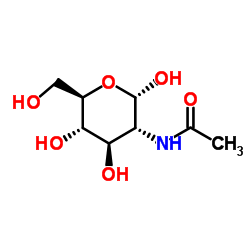
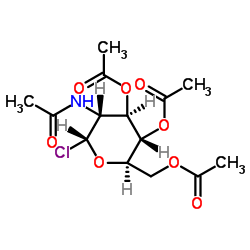
![N-[(2S,3R,4R,5R,6R)-2-(2-azidoethoxy)-4,5-dihydroxy-6-(hydroxymet hyl)tetrahydropyran-3-yl]acetamide结构式](https://image.chemsrc.com/caspic/076/195384-42-0.png)
